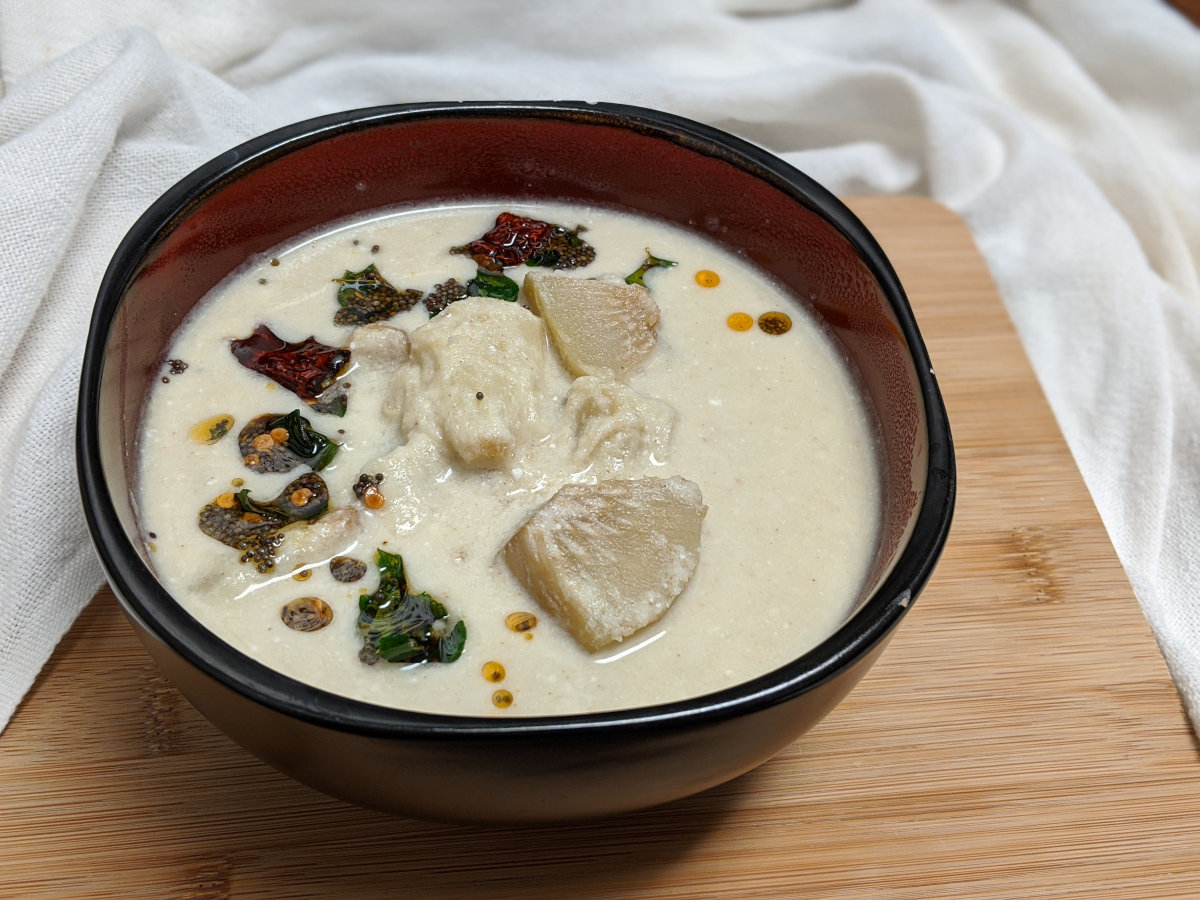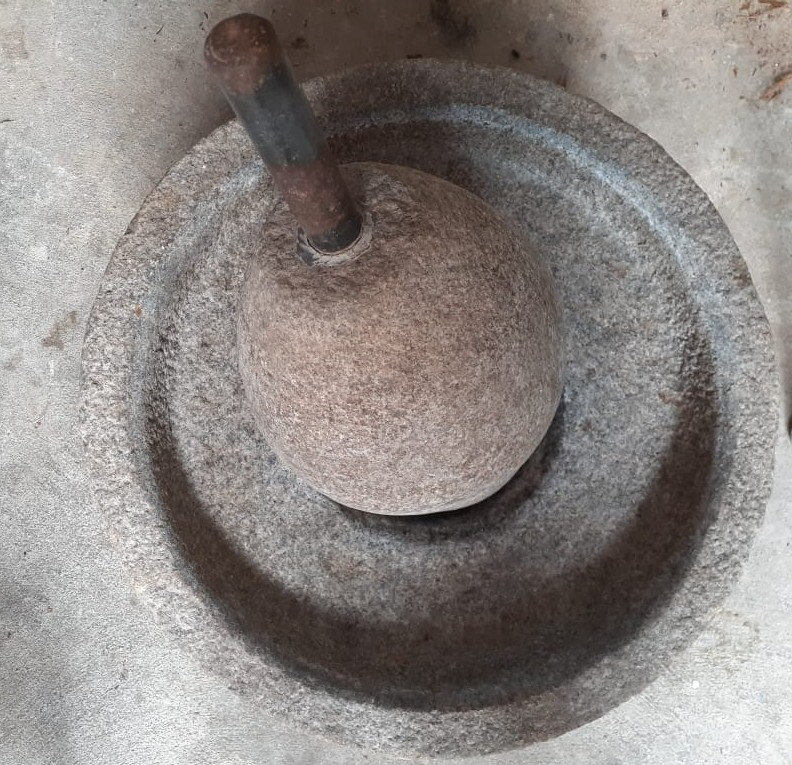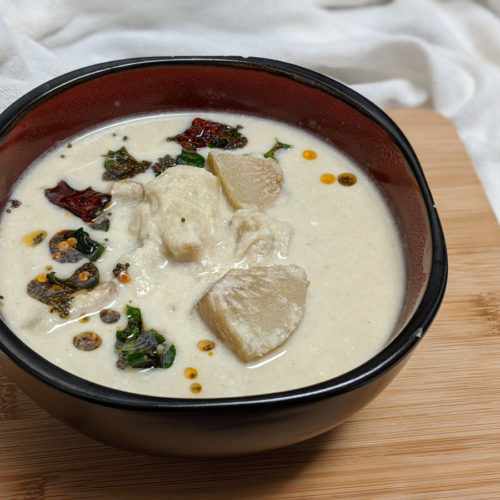Majjige huli/melara/coconut yogurt curry

Majjige huli, called melaara in Havyaka language is one of the cornerstones of Havyaka cuisine. There is no festive meal without it. Spices that go into this dish are next to none and that makes the taste of vegetables shine through. Whoever came up with this dish, hundreds of years ago was a genius! You are SO wrong if you think it may taste bland. The balance of flavors in this dish is excellent, which in turn makes you satisfied with your meal.
Now a short language lesson. Majjige means buttermilk, the liquid left over after churning out butter from yogurt. Huli means sour. Majjige huli literally translates to buttermilk sour!
Back in the day, when not everyone owned an electric blender, huge manual stone grinders were used to grind the coconut into a fine paste. Imagine it as a huge mortar and pestle. My grandma, who was an excellent cook, had an extra huge one used to grind large quantities of coconut. Come summer holidays, with her kids and grandkids visiting, I still vividly remember the outdoor kitchen, where not one but two people sat on opposite sides of the huge stone grinder, moving it around together, producing huge amounts of ground coconut for big potfuls of sambar or melara (majjige huli). Laughter and chatter all around! Even the most strenuous of chores seem easy when family works together!

While you can definitely prepare majjige huli with any vegetable, traditionally some vegetables are used more than others to make it. They are
Tindora (ivy gourd, tondekai)
Winter melon (kumbala kai)
Mangalore cucumber (Mangalore southekai)
A mix of tindora and Mangalore cucumber
Bread fruit (jee gujje)
Yard long beans (alasande)
Root vegetables native to the region
Wild berries native to the region like curry fruit (kaana kallate) well, the list can go on.
How majjige huli is made
Cook the vegetable with water just enough to barely cover it. Optionally a slit green chilli can be added along with the vegetable. Some people also add a pinch of turmeric and chilli powder when cooking the vegetables.
Grind coconut along with a green chilli and a few curry leaves. Add this into the cooked vegetables and bring it to a gentle boil. Add in the buttermilk (liquid left behind after churning butter out from yogurt) or beaten yogurt. Reduce heat and do not boil after yogurt has been added. Finally add an oggarane (seasoned hot oil) into majjige huli.
How majjige huli is eaten
Majjige huli is eaten mixed with rice. A side of palya (stir fried vegetable dish) completes the meal.
Things to remember to make good majjige huli
- Do not get majjige huli to a roaring boil after adding in the coconut paste. Gently get it to a boil on medium heat. On high heat, coconut tends to curdle and separate.
- Be more careful with the heat after adding in the yogurt. Reduce heat to lowest and when you see the tiniest hint of it starting to boil, turn the heat off and remove from heat if using an electric stovetop.
Today I am making majjige huli using bread fruit also called as jee gujje in Mangalore. It is this spiky looking tropical fruit, looks like a baby jackfruit from the outside. The insides turn creamy, soft and oh so yummy on cooking. I rarely ever find fresh bread fruit here in the US, but we do get them frozen at Indian grocery stores. Frozen ones are definitely not as tasty as fresh, but good enough for when a craving hits.

Majjige huli/melara/coconut yogurt curry
Equipment
- blender/mixer-grinder
Ingredients
- 1 1/2 cups Bread fruit /jee gujje 200g
- 1 cup water plus more as needed
- ¼ cup yogurt
To blend together
- ¾-1 cup grated coconut fresh or frozen
- 1 green chilli
- 3-4 curry leaves
For tempering
- 1-2 tsp oil
- ½ tsp mustard
- 1 dry red chilli broken
- 6-7 curry leaves optional
Instructions
- Wash the vegetable add a cup of water and set it on the stovetop to cook. Optionally, add a green chilli, a pinch of turmeric and chilli powder while cooking the vegetable. Cover and cook stirring occasionally for 5-10 minutes or until fork tender.
- When the vegetable is cooking defrost the coconut if using frozen. Add it into a blender along with a green chilli and 3-4 curry leaves. Add just enough water for the blender to do it’s job and blend the coconut into a smooth paste.
- Add the coconut paste into the cooked vegetable, add more water to suit your desired consistency and get majjige huli to a gentle boil, on medium heat, stirring occasionally.
- When you see some bubbles forming, add the beaten yogurt or buttermilk and reduce the heat to lowest.
- Turn off the heat when tiniest of bubbles form. Remove from heat if using an electric stovetop.
- For tempering, take oil in a small pan, add mustard seeds and broken dry red chilli. When mustard splutters, add curry leaves and pour this heated oil over the majjige huli and cover with a lid.
- Enjoy it mixed with rice.
Love the recipe. Could you also add pictures of possible if when your making the dish. So I know I’m it the right way. I find that pictures work really well in recipes
That’s right. Thank you for the suggestion! Planning to do it in the coming recipes. Will update this recipe as well with pictures in the near future!
👌
Thank you!